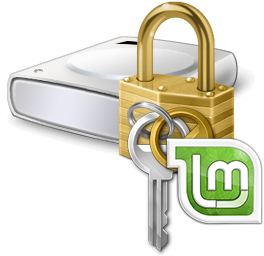Dislocker Or find a common language with BitLocker in Linux Mint

The first question that may arise from the reader who read the title: "Why?". Indeed, in Linux Mint, you can quietly do without proprietary BitLocker. In addition, the main advantages of this technology, which include the ease of use and creation of encrypted partitions, as well as support "out of the box" in all the latest operating systems from Microsoft, are manifested only in operating systems from Redmond. In addition, free software with similar, or even somewhat superior BitLocker functionality in nix systems is sufficient - for example, TrueCrypt.
In many ways, I share this point of view, but there are times when BitLocker is needed and the OS is Linux Mint.
After some experiments with various Linux distributions, my choice fell on Linux Mint 16 x64 Cinnamon. I decided to abandon Windows completely (though, so far, only on a laptop). Mint suits me completely: documents open, music plays, films are shown and in general the system makes me happy with its stable work (pah-pah). But at some point it became necessary to work with BitLocker partitions. On the one hand, I don’t want to part with Linux Mint, but on the other hand, something has to be done with Bitlocker. I didn’t want to go back to “2in1” on a laptop. One of the first thoughts that came to mind was a virtual machine with Win7 on board.
Dislocker
As it turned out, to teach Mint to work with BitLocker encrypted partitions is quite realistic. DisLocker can help in the implementation of the plan.
')
Currently, DisLocker v.0.3 provides almost all the necessary tools for working with encrypted BitLocker partitions. There are of course some limitations and flaws. For example, the inability to work with partitions created in Vista. Also, the program does not know how to work with FAT-sections. The documentation about this does not say anything, the problem was discovered in the process. The author of the program Romain Coltel promised to eliminate this flaw in the near future. In addition, the utility does not allow creating encrypted partitions. If we take into account the fact that some editions of Microsoft operating systems are deprived of this possibility, you should not expect this feature to appear in DisLocker.
Despite these shortcomings, DisLocker is already able to provide reading and writing to encrypted NTFS partitions, which is quite enough for normal operation. In addition, the utility is being developed. Recently, it has become possible to access not only by the recovery password, as it was before, but also by the user's password, as well as using an external key file.
DisLocker supports two modes of operation:
- FILE
- FUSE
In FILE mode, the entire BitLocker partition is decrypted into a file. This process can take considerable time, depending on the size of the partition.
The second mode involves the use of FUSE (Filesystem in Userspace) - a file system driver that allows users to create their own file systems without privileges without having to rewrite kernel code. In FUSE mode, encryption occurs on the fly. Only the block to which the system is currently accessing is deciphered. Of course, when using this mode, the access time increases slightly, but it is much safer.
In what mode DisLocker will be used, you should decide before building the package.
Installation
I have chosen to work with FUSE, which is offered by default.
First of all, download the source and unpack:
tar -xvf dislocker.tar.gz To use DisLocker in FUSE mode, you need to install the libfuse-dev package:
sudo apt-get install libfuse-dev Next, go to / path / dislocker / src and proceed to build the package. In this case, everything could be done through make / make install, but let's not get used to doing it wrong. We will do everything in Feng Shui , using checkinstall:
sudo checkinstall Upon completion of the build and installation process, checkinstall will tell us “Done”.
Next, look for our encrypted partition using fdisk –l and set DisLocker on it:
sudo dislocker –V /dev/sdb1 –uSECRET /mnt/dislocker Where:
/ dev / sdb1 - encrypted partition;
SECRET - user password;
/ mnt / dislocker - mount point of the file. The file is a virtual NTFS partition, so it can be mounted like any other NTFS partition:
sudo mount -o loop,ro /mnt/tmp/dislocker-file /mnt/BitLocker This completes the BitLocker partition. You can work.
Source: https://habr.com/ru/post/210938/
All Articles